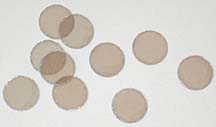
Specializes in HIGH-TECH MICA: Natural Muscovite MICA ASTM-V-1 QUALITY TO .0001†THICKNESS; OPTICALLY FLAT, CLOSE TOLERANCES, precision punching and lathe turning. We also supply ASTM-V-1 MICA SLIDES, MICA DISCS AND MICA INSULATORS. We are capable of fabricating Mica ASTM-V-1 products in different shapes, e.g. Mica Discs, Mica Windows in round, square, rectangle, electronic components or as per customer’s drawings/specs or samples.
Freshly cleaved surfaces of mica are very useful for such electron microscopy substrate applications as carbon filming and particle spraying. The preferred mica for these applications is the muscovite type. The mica is die cut to the sizes offered. Thickness is variable between approximately 0.02 – 0.25mm (0.007 – 0.01″) with some pieces laying outside this range.
Ruby muscovite color ranges from almost white through pink to a light ruby and into shades of brownish ruby and brown. It is considered of higher quality (compared to green muscovite) because of hardness and excellent cleavage properties permitting it to be split into the thinnest desired film without the risk of cracking. It is optically flat, resilient and incompressible. While it splits into thin films along its cleavage planes, yet it remains tough and elastic, even at high temperature.
Chemically, mica is a complex hydrous silicate of aluminum, containing potassium, magnesium, iron, sodium fluoride and/or lithium and traces of other elements. It is stable and inert to water, acids (except hydrofluoric and concentrated sulfuric acids), alkalis, conventional solvents and oil.
Our mica has minimum inclusions, minimum air and bubbles and is clean. ASTM D-351 describes grading standards for mica.
Cleaving mica involves insertion of a sharp edge or point into an edge or corner of the sheet and gently prying apart the leaves. A good razor blade edge will do the job and in some cases a sharp pointed tweezer may accomplish the mission. The freshly exposed mica surface is very helpful as used in various Microscopist’s technologies such as carbon coating and growing cells.